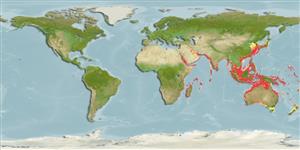Teleostei (teleosts) >
Eupercaria/misc (Various families in series Eupercaria) >
Haemulidae (Grunts) > Plectorhinchinae
Etymology: Plectorhinchus: Greek, plektos = plaited + Greek, rhyngchos = snout (Ref. 45335).
Environment: milieu / climate zone / depth range / distribution range
Ecology
Marine; reef-associated; depth range 20 - 200 m (Ref. 28016). Tropical
Indo-West Pacific: Persian Gulf to Sri Lanka (Ref. 11441). Elsewhere, eastward extending to China (Ref. 3412).
Length at first maturity / Size / Weight / Age
Maturity: Lm 53.6, range 40 - ? cm
Max length : 83.0 cm TL male/unsexed; (Ref. 40637); max. published weight: 6.9 kg (Ref. 40637)
Inhabits coastal waters. Caught throughout its range; not common. Marketed fresh (Ref. 3412). Juveniles are used in the aquarium industry (Ref. 9137)
Life cycle and mating behavior
Maturities | Reproduction | Spawnings | Egg(s) | Fecundities | Larvae
Oviparous, distinct pairing during breeding (Ref. 205).
McKay, R.J., 1984. Haemulidae. In W. Fischer and G. Bianchi (eds.) FAO species identification sheets for fishery purposes. Western Indian Ocean (Fishing Area 51). Vol. 2. FAO, Rome. pag. var. (Ref. 3412)
IUCN Red List Status (Ref. 130435)
Threat to humans
Harmless
Human uses
Fisheries: commercial; aquarium: commercial
Tools
Special reports
Download XML
Internet sources
Estimates based on models
Preferred temperature (Ref.
123201): 21.1 - 28.2, mean 26.3 °C (based on 926 cells).
Phylogenetic diversity index (Ref.
82804): PD
50 = 0.5000 [Uniqueness, from 0.5 = low to 2.0 = high].
Bayesian length-weight: a=0.01862 (0.01346 - 0.02576), b=2.91 (2.82 - 3.00), in cm total length, based on LWR estimates for this species (Ref.
93245).
Trophic level (Ref.
69278): 3.9 ±0.0 se; based on diet studies.
Resilience (Ref.
120179): Low, minimum population doubling time 4.5 - 14 years (K=0.21; tm=5-7).
Fishing Vulnerability (Ref.
59153): Moderate to high vulnerability (52 of 100).
Climate Vulnerability (Ref.
125649): High to very high vulnerability (75 of 100).
Nutrients (Ref.
124155): Calcium = 20.7 [9.6, 42.9] mg/100g; Iron = 0.507 [0.253, 0.947] mg/100g; Protein = 18.9 [16.9, 20.8] %; Omega3 = 0.107 [0.052, 0.196] g/100g; Selenium = 51.4 [26.6, 100.5] μg/100g; VitaminA = 58.2 [17.2, 196.9] μg/100g; Zinc = 0.689 [0.447, 1.047] mg/100g (wet weight);
